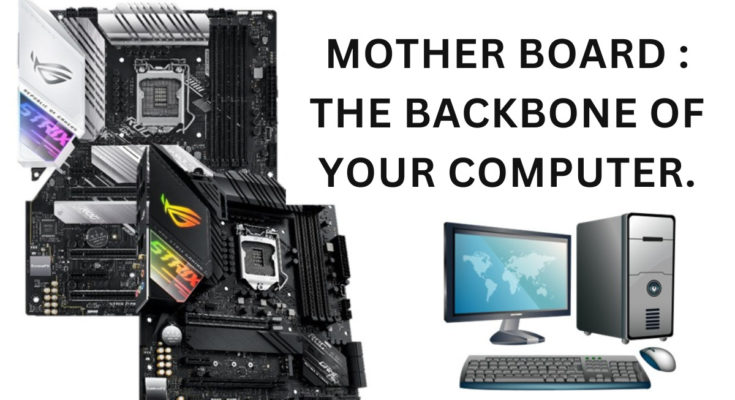A motherboard, also known as the mainboard, baseboard, or system board, is a printed circuit board (PCB) that connects and controls various components of a computer system. It serves as the central hub that connects the CPU, memory, storage devices, graphics card, and other peripherals.
The motherboard also provides the necessary electrical connections and interfaces to enable communication between these components. It typically contains several key components such as the chipset, BIOS, expansion slots, input/output (I/O) ports, and power connectors.
The chipset, which is integrated into the motherboard, manages communication between the CPU, memory, and other peripherals. The BIOS (Basic Input/Output System) is firmware that initializes and configures the hardware components of the computer system during the boot process. The expansion slots on the motherboard allow for the installation of additional components such as graphics cards, sound cards, and network cards.
Overall, the motherboard plays a crucial role in the functioning of a computer system by ensuring that all components work together seamlessly.
MOTHER BOARD: THE BACKBONE OF YOUR COMPUTER
The motherboard can be considered as the backbone of a computer because it connects and controls all the components of the computer system. It provides a platform for the CPU, RAM, storage devices, graphics card, and other peripherals to work together and communicate with each other.
The motherboard also determines the maximum capacity and compatibility of the components that can be installed in the computer. It serves as the foundation upon which the entire computer system is built.
Without a properly functioning motherboard, a computer would not be able to function. Therefore, it is essential to choose a reliable and compatible motherboard for your computer system to ensure optimal performance and stability.
TYPES OF MOTHERBOARDS.
There are several types of motherboards, which can be classified based on factors such as form factor, processor socket type, chipset, and intended use. Here are some of the most common types of motherboards:
1. ATX:
Advanced Technology Extended (ATX) is a popular form factor for motherboards, designed to be compatible with a wide range of computer cases. ATX motherboards typically have four to seven expansion slots and a variety of ports and connectors.
2. Micro-ATX:
Micro-ATX is a smaller form factor than ATX, designed to be used in compact computer cases. Micro-ATX motherboards typically have fewer expansion slots than ATX motherboards, but are still capable of supporting a range of components.
3. Mini-ITX:
Mini-ITX is an even smaller form factor than Micro-ATX, designed for use in compact, low-power systems such as home theater PCs. Mini-ITX motherboards typically have just one expansion slot and a limited number of ports and connectors.
4. LGA and PGA:
Motherboards can also be classified based on the type of processor socket they use. Intel processors typically use Land Grid Array (LGA) sockets, while AMD processors use Pin Grid Array (PGA) sockets.
5. Chipset:
Motherboards can also be classified based on the type of chipset they use. The chipset is a set of integrated circuits that controls the communication between the processor, memory, and other components. Popular chipset brands include Intel, AMD, and NVIDIA.
6. Server motherboards:
Server motherboards are designed for use in servers and other enterprise-level systems. They typically support multiple processors, have more memory slots, and offer features such as RAID support and remote management capabilities.
7. Gaming motherboards:
Gaming motherboards are designed for high-performance gaming systems, with features such as overclocking support, high-speed memory, and advanced audio and networking capabilities.



